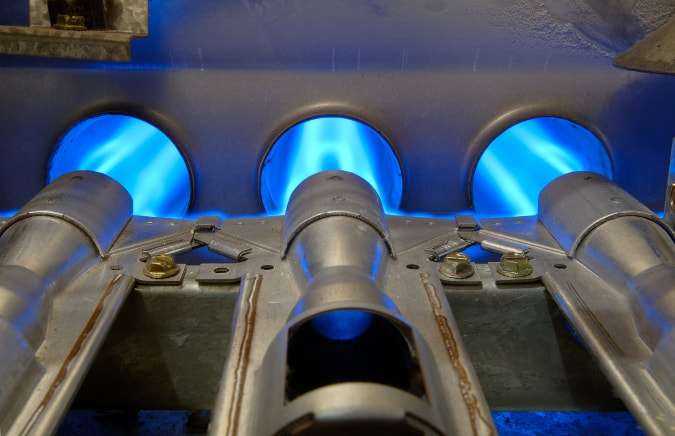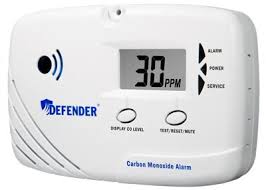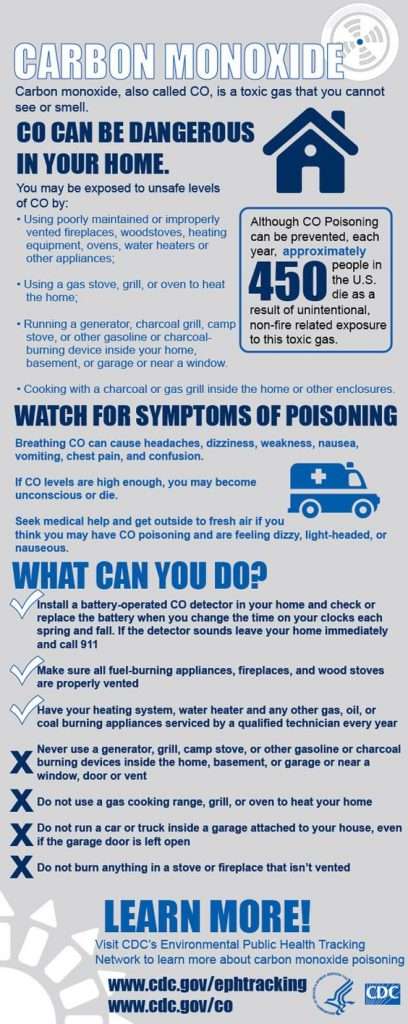Carbon monoxide, the poisonous, colorless, odorless and tasteless gas responsible for more than 20,000 visits to the emergency room every year, can pose a danger from unforeseen sources in your home, including fireplaces, water heaters and generators. Improper ventilation of fuel-burning appliances and exhaust from running automobile engines in attached garages are ordinarily associated with dangerous carbon monoxide levels. Another potential origin of carbon monoxide in your living space is your furnace.

Gas burners of a furnace providing heat to the heat exchanger. 
What is a heat exchanger and why is it critical?
A furnace’s heat exchanger is a metal component that transfers heat from the fuel being burned while blocking the air in your home from mixing with the furnace exhaust. Sometimes the heat exchanger fails, either from cracks produced by continual expansion and contraction due to heating and cooling of the metal or from rust. When a heat exchanger fails—under specific conditions—the exhaust gases, including carbon monoxide, can mix with the air in the house. A properly running furnace should not create significant levels of carbon monoxide; however, a cracked or leaking heat exchanger can pose a serious and life-threatening safety hazard.
What happens after an HVAC technician diagnoses a cracked heat exchanger?
Once you have a confirmed diagnosis from an expert, your initial question will likely be whether the part can be repaired or if a replacement is the only option. Unfortunately, the industry standard is that the heat exchanger must be replaced. In fact, the American Gas Association advises that any visible crack or hole is the reason for requiring replacement of the heat exchanger or furnace. It’s not uncommon for us to come behind P.G.&E. who has recently Re-Tagged a furnace for unsafe operation due to a cracked heat exchanger.
How can I be sure that my heat exchanger really has failed?
Bradford Air & Heating’s certified technicians have received specialized training in identifying a cracked heat exchanger. As standard practice and in addition to physically observing the presence of a hole or crack, cameras are used along with CO meters. Whenever possible, the technician will show customers the failed heat exchanger—or at least a photo of it—so they can see for themselves. Additionally, an expert technician will test both the rest of the home for carbon monoxide. A properly running furnace should not generate significant levels of carbon monoxide. The technician will then warn the customers of the dangers associated with the failed part and provide professional advice regarding next steps. In extreme cases, we will also shut off the gas to the furnace so you don’t accidentally run the furnace.
What are the dangers correlated with a cracked heat exchanger?
A cracked heat exchanger could allow exhaust gas from the furnace to infect the household air with exhaust gases including carbon monoxide. In order for this to happen, the furnace must be emitting high levels of carbon monoxide and the exhaust gas must be combining with the household air. This could lead to serious illness and even death.
What are the warnings of a cracked heat exchanger?
In addition to a visual inspection to identify a crack, there are a few warnings of a potential complication with your heat exchanger that you may observe. If you turn the heat on and the flames flicker and seem devilish, this could be a clue that circulated air from the furnace is getting into the combustion area and you should have it examined by an HVAC technician. Although you certainly hope it doesn’t reach this point, other characteristics of trouble include carbon monoxide detectors sounding and you or your family members feeling sick, lightheaded or nauseous. To ensure the safety of all occupants, all homes should have a properly functioning carbon monoxide detector and batteries should be replaced routinely.
If my heat exchanger has failed, do I have to replace the furnace?
While it may end up making sense to replace the furnace rather than only the heat exchanger, that is not always the case. Furnace warranties can vary—most furnaces have a 10-year warranty on the heat exchanger, while some are covered for 20 years or even for the life of the furnace. Our technicians will help you investigate the warranty on your heat exchanger and provide all the information you need to decide if replacing the heat exchanger or the entire furnace is right for you.
Bradford Air & Heating suggests changing your carbon monoxide detectors every five years and checking your carbon monoxide detectors each month to make sure the batteries and alarm are working properly. We can also help you select the best carbon monoxide detector for your home. There are plenty to choose from including low-level carbon monoxide detectors that can be ordered for you. And by keeping up with the normal maintenance of your equipment, you will have peace of mind knowing that it’s going to be safe. A carbon monoxide test is included with every furnace tune-up and service call we perform. If you suspect a problem with your heat exchanger or need to have an analysis of carbon monoxide levels in your home, call Bradford Air & Heating today at (925) 804-4684 or contact us. We are happy to help with your home heating in Livermore, Pleasanton, Dublin, and Beyond.

Don’t forget to visit and like our Facebook page or follow us on Instagram to get up to date information along with being the first to know about our limited time specials.
The post Carbon Monoxide And Heat Exchangers appeared first on Bradford Air & Heating.

